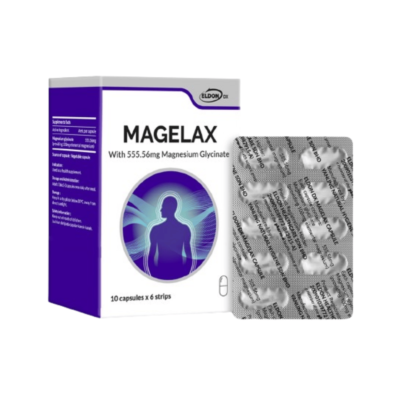This health article has been professionally reviewed by RPh Marcus Ang, a registered pharmacist of the Malaysian Pharmacists’ Society (MPS).
Magnesium is the eleventh most abundant element in the human body, with approximately 50% to 60% stored in the bones and the remainder primarily found in soft tissues and muscles (1). This mineral plays a critical role in more than 300 enzymatic reactions essential to human health. Its influence spans neurological, muscular, and cardiovascular functions, including (2):
- Supporting muscle and nerve function
- Aiding in protein and energy synthesis
- Regulating blood glucose and blood pressure
Magnesium is naturally present in a wide range of plant- and animal-based foods. Excellent dietary sources include green leafy vegetables (like spinach), legumes, nuts, seeds, and whole grains.
In general, foods rich in dietary fiber tend to be good sources of magnesium. For instance, 100 grams of cashew nuts provide about 292 mg of magnesium, and almonds offer around 225 mg—both significantly higher than 100 grams of tuna fish, which contains only 40 mg3.

While deficiencies of minerals such as iron and calcium are often linked with well-defined conditions like anemia, rickets, or osteoporosis, magnesium deficiency is more subtle and can be harder to recognize.
Symptoms of Magnesium Deficiency
Early symptoms may include loss of appetite, nausea, vomiting, fatigue, and general weakness. As the deficiency becomes more severe, individuals may experience numbness, tingling, muscle cramps, seizures, personality changes, abnormal heart rhythms, and coronary spasms (4, 5). Additionally, severe magnesium deficiency can lead to hypocalcemia or hypokalemia—low levels of calcium or potassium—due to disrupted mineral balance in the body (5).
Notably, frequent headaches or migraines could serve as an early warning sign. Research indicates that individuals who suffer from migraines often have lower levels of magnesium in their serum and tissues compared to those who do not (6, 7).
Types of Magnesium Supplements
To address low magnesium levels, magnesium supplements are available in several forms, each with different absorption rates and therapeutic uses. Common types include magnesium oxide, citrate, chloride, and glycinate. For example:
- Magnesium oxide is often found in antacid products for indigestion and heartburn relief (8).
- Magnesium citrate is used to treat occasional constipation on a short-term basis (9).
- Magnesium glycinate is preferred for its better absorption10 and therefore used to support relaxation and better sleep.
Given its essential role in numerous physiological processes, ensuring adequate magnesium intake, whether through diet or supplementation, is vital for maintaining overall health. Both healthcare professionals and the public should be aware of the signs of deficiency and the best sources to support well-being. Learn more about types of magnesium here!
Reference:
- Volpe SL (2012). Magnesium. In: Erdman JW, Macdonald IA, Zeisel SH (eds) Present Knowledge in Nutrition. 10th ed. Ames, Iowa; John Wiley & Sons: 459-474.
- National Institutes of Health, Office of Dietary Supplements. (2022, March 22). Magnesium – Health Professional Fact Sheet. U.S. Department of Health and Human Services. https://ods.od.nih.gov/factsheets/Magnesium-HealthProfessional/
- U.S. Department of Agriculture, Agricultural Research Service (2012). USDA National Nutrient Database for Standard Reference, Release 25. Nutrient Data Laboratory Home.
- Institute of Medicine (IOM) (1997). Food and Nutrition Board. Dietary Reference Intakes: Calcium, Phosphorus, Magnesium, Vitamin D and Fluoride. External link disclaimer. Washington, DC: National Academy Press.
- Rude RK (2010). Magnesium. In: Coates PM, Betz JM, Blackman MR, Cragg GM, Levine M, Moss J, White JD (eds). Encyclopedia of Dietary Supplements. 2nd ed. New York, NY: Informa Healthcare:527-537.
- Karim, M. R., Bhattacharjee, M., Islam, M. S., Banerjee, S., Hossain, S., Hossain, M. I., & Haidar, M. R. (2021). Relation between Serum Magnesium Level and Migraine. Mymensingh medical journal : MMJ, 30(2), 301–306.
- Dominguez, L. J., Veronese, N., Sabico, S., Al-Daghri, N. M., & Barbagallo, M. (2025). Magnesium and Migraine. Nutrients, 17(4), 725. https://doi.org/10.3390/nu17040725
- National Library of Medicine. (2024, June 20). Magnesium oxide. MedlinePlus. https://medlineplus.gov/druginfo/meds/a601074.html
- National Library of Medicine. (2019, April 15). Magnesium citrate. MedlinePlus. Retrieved April 29, 2025, from https://medlineplus.gov/druginfo/meds/a619019.html
- Schuette, S. A., Lashner, B. A., & Janghorbani, M. (1994). Bioavailability of magnesium diglycinate vs magnesium oxide in patients with ileal resection. Journal of Parenteral and Enteral Nutrition, 18(5), 430–435. https://doi.org/10.1177/0148607194018005430







